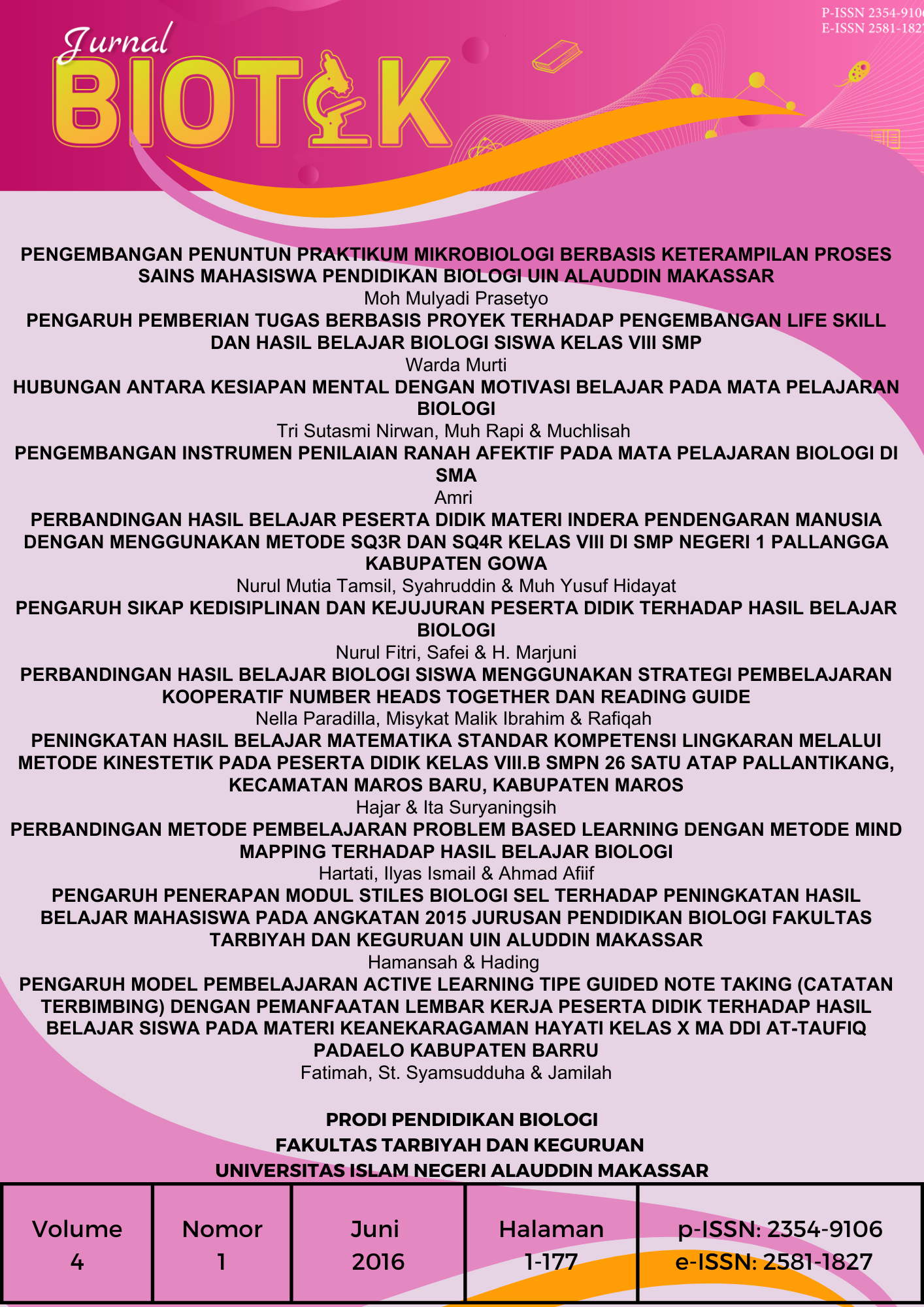PENGARUH PENERAPAN MODUL STILES BIOLOGI SEL TERHADAP PENINGKATAN HASIL BELAJAR MAHASISWA PADA ANGKATAN 2015 JURUSAN PENDIDIKAN BIOLOGI FAKULTAS TARBIYAH DAN KEGURUAN UIN ALUDDIN MAKASSAR
Abstract
This study is a Quasi Experiment because this research has not fully controlled for factors internal and external research. Two rombel student of biology and biological ½ ¾ given application module system STLeS Biology Sel. The research location is housed in the building Tarbiyah and Teaching UIN Alauddin Makassar. This study aims to (1) determine student results before taught using Stiles modules Cell Biology Department of Biology Education class of 2015; (2) determine student results after Stiles taught using modules Cell Biology Department of Biology Education class of 2015; (3) the effect of the application of Cell Biology Stiles module to the learning outcomes of students in the class of 2015 the Department of Biology Education. The population in this study were all students of biology class biology ½ and ¾, the semester consisting of two classes or four groups. In this study, there were 75 people population, so that everything becomes the study sample consisted of two study groups. Each of the two study groups are learning to use the module Stiles Biology Sel. The results showed that (1) the results of student learning cell biology before taught using Stiles Module Cell Biology is an average of 49.24; (2) The study of cell biology students after being taught using Stiles Module Cell Biology is an average of 85.72; (3) Module Cell Biology Stiles affect the improvement of student learning outcomes biology education class of 2015. It can be seen from the analysis parameter estimation value sig. count (0,000) <sig. table (0.05). So the hypothesis was accepted because the significance value calculated is less than the significance of the table
Downloads
References
Arikunto, Suharsimi. (2006). Prosedur penelitian (Suatu Pendekatan Praktek). Jakarta: Rineka Cipta
Hasan, M. Iqbal. (2004) Pokok-Pokok Materi Statistik 2; Statistik Inferensial. Jakarta: PT. Bumi Aksara
Hermawati. (2009). Peningkatan Hasil Belajar Matematika melalui Penerapan CIPP Evaluation Model Pada Siswa Kelas VIIB MTs. Muallimin Makassar. Skripsi. Fakultas Tarbiyah dan keguruan, UIN Alauddin Makassar.
Sudjana, Nana (1991). Penilaian Hasil Proses Belajar Mengajar. Bandung: PT.Remaja Rosdakarya.
Putra, Nusa. (2013). Penelitian kualitatif Pendidikan Agama Islam. Bandung: PT Remaja Royadakarya.
Risnawati. (2009). Penerapan Teori Belajar Sibernetik dalam Meningkatkan Hasil Belajar Siswa Kelas VIII Mts. No.20 Bontosunggu Kabupaten Bulukumba. Skripsi. Fakultas Tarbiyah dan keguruan, UIN Alauddin Makassar.
Sanjaya, Wina. (2007). Strategi Pembelajaran. Kencana: Jakarta.
Sugiyono. (2006). Metode Penelitian Administrasi. CV. Alfabeta: Jakarta
Sugiyono. (2015). Metode Penelitian Pendidikan. CV. Alfabeta: Bandung.
Sudarajat, Ahmad. 31 Januari 2008. Hakikat Belajar. Online.. (Diakses di http/www google. com/firefox pada 05 Januari 2010)
Zulfahmi. (2015). STILeS. Makalah Pelatihan STILeS UIN Alauddin Makassar. Makasaar.
Authors who publish with Jurnal Biotek agree to the following terms: Authors retain the copyright and grant Universitas Islam Negeri Alauddin Makassar right of first publication with the work simultaneously licensed under a Creative Commons Attribution License (CC BY-SA 4.0) that allows others to share (copy and redistribute the material in any medium or format) and adapt (remix, transform, and build upon the material) the work for any purpose, even commercially with an acknowledgement of the work's authorship and initial publication in Universitas Islam Negeri Alauddin Makassar. Authors are able to enter into separate, additional contractual arrangements for the non-exclusive distribution of the journal's published version of the work (e.g., post it to an institutional repository or publish it in a book), with an acknowledgement of its initial publication in Universitas Islam Negeri Alauddin Makassar. Authors are permitted and encouraged to post their work online (e.g., in institutional repositories or on their website) prior to and during the submission process, as it can lead to productive exchanges, as well as earlier and greater citation of published work (See The Effect of Open Access).

This work is licensed under a Creative Commons Attribution-ShareAlike 4.0 International License.



